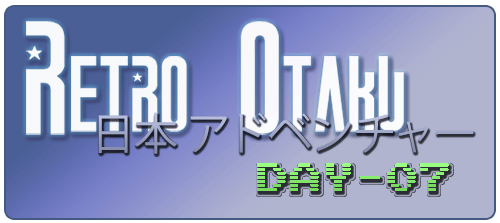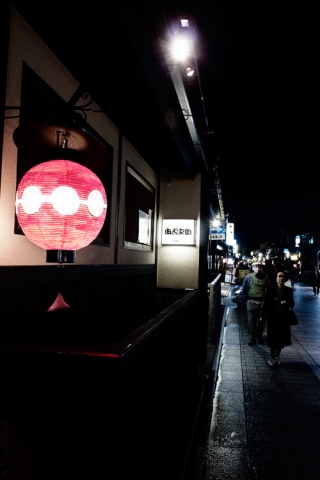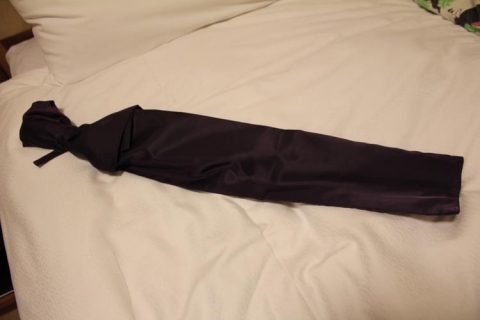Japan 2012 Travel Diary, Day 7

Day two in Kyoto continued the cultural expeditions. We started off by heading to Kyoto Station and jumping on the tourist bus to visit the Ginkakuji Temple – the place was absolutely mind-blowing and picturesque, and the grounds were much bigger than we had anticipated.
At this stage in the trip my prosthesis had started causing me some grief due to all the walking/getting lost/exploring, so we decided to cut the walk around the temple grounds short and get started on the Philosopher’s Path. When my brother Tank and his wife visited earlier in the year during the cherry blossom viewing season the place looked beautiful, so it was awesome to get a chance to see it in autumn when the leaves were changing colour. As the rain and clouds had cleared up, it was also nice and sunny out (though a bit chilly since the humidity had gone with the cloud cover), so we made our way leisurely down the path, stopping to take photos, and at one point we dropped into a neighbourhood tea and coffee place for a couple of cake sets (Wifey has the cheesecake and coffee, while I enjoyed a green tea rolled cake with fresh cream and stuffed with red beans paste with a cup of tea).
The real magic though happened at the end of the trail. As part of my Shenmue obsession I found a small deserted park with some play equipment at the end of the street, and so I asked myself – “What would Ryo Hazuki do in this situation?”. That’s right, he’d take the time to work on his moves. So, announcing to nobody in particular “Let’s get sweaty”, I decided to get my karate on and run through a couple of techniques, with the ever-patient Wifey indulging the experience by snapping some photos. Not having trained over the last 18+ months due to some health concerns my form was pretty rubbish, but the experience was worth it 🙂
After making an arse of myself in public (again), we finished off the Philosopher’s Park walk to wander down along the backstreets of Kyoto to either grab a bus or walk to a nearby precinct some fellow martial artists had recommended I check out whilst in Kyoto. We ended up walking the whole way (probably about 40 minutes since we were taking our time), with Wifey’s iPhone (still on iOS5 and therefore still with the native Google Maps app) taking care of tracking our way thanks to a cached map of this area in Kyoto, because even with no mobile data, the GPS still kicked in. This eventually lead us to our next destination, the Kyoto Handicraft Centre.
On account of some renovations, the bottom floor of the building was unavailable, which meant the usually-extensive selection on the street level of this complex was not available (the bottom floor of the neighbouring building was the acting substitute, but it was much smaller than the original one). Unperturbed we headed up a few floors to check out things, and were greeted by a large range of regional crafts, including ceramics, lacquerware, dolls, display swords (not suitable for training in kenjutsu or iaido) and one large iaito. Since I had already picked up a small wakizashi-sized iaito in Suidobashi I wasn’t specifically looking for another one, but was curious to see what was there just in case 😉 Looking at the lovely iaoto, due to the size of the sword it wasn’t appropriate to bring back since it wouldn’t fit in the suitcase, but it did look nice 🙂 For those keen on bringing something back, the display sword sets started around ¥8,000 and topped out around ¥13,000; the iaito was around the ¥84,000 mark.
While we were down this end of Kyoto, we also wandered across the road (literally) to visit Tozando, a specialist store for iaito, kendo equipment (shinai and protective gear), kobudo equipment, general training garments (including protector pads and mitts) and on the second floor they had an array of stunning swords and armour, including original antiques from various eras in Japan’s history. For those interested in bringing back an antique sword, you’re looking at investing a huge chunk of cash (and apparently it can be tricky bringing them out of the country as antique swords are considered part of Japan’s history and are thus treated as national treasures), but for the rest of us, simply walking through this area is an amazing experience. Luckily for Wifey, they have the unintended presence of girlfriend/wife/”I dragged along my other half” seats in front of a TV playing a documentary on the second floor that houses their mini-museum of antique pieces, so she sat there while I gushed. Tozando did have some very nice wakizashi iaito, but at this stage I was happy with my purchase from Suidobashi and decided to leave it be. If ever I came back to Japan and was heading to Kyoto though, I suspect I’d probably hit Tozando for another iaito – they’ve had some great reviews amongst other iaido practitioners and the gear looked really nice.
After wandering to the end of the street and grabbing a subway train back to Karasuma-Oike, we stopped off for a quick bite at Caffe Excelsior – I grabbed a beef stew wrap (literally, beef stew goodies/gravy inside a wholemeal wrap lightly toasted) and Wifey enjoyed a Paris Sandwich, which was a delightful roll filled with chicken, a yummy white sauce with fresh mushrooms, and melted Camembert cheese. Next on the list for Day 2 was a short meander up Karasuma-dori to visit another spot of hallowed ground – the Kyoto Manga Museum.
Given anime and manga fanboyisms seem happy to collocate themselves in a gamer’s psyche (I was a gaming nerd before I jumped aboard the anime and manga nerd train in the early-mid 90s), it probably isn’t too surprising this visit was another unforgettable experience. The museum is actually housed within an old Kyoto primary school that was vacated in the mid-90s, and contains an enormous collection of manga in serialised book format, manga in magazine format, displays, artwork and miniature exhibitions. The cool thing is that almost all the manga in book format can be taken off the shelves and read, with the majority of the available books the resulting donation of a commercial manga library run for many years when the owner closed up his business. This means when you’re picking up a copy of Ranma 1/2 or Bishoujo Senshi Sailormoon (which I did!), you’re enjoying the same book that was originally printed when the title was released, and the same book has also been through the hands of so many other readers. It’s not just a piece of cultural history, it’s equally a tangible piece of social history as well. The museum actually offers pre-paid passes during the year so if you want to drop in on a regular basis (such as after school or work) to have a read before going home, you can do so and treat it as a reference library of manga.
One of the permanent exhibitions is a room that houses manga in chronological order, from the 50s onwards. Walking around this meant you were also able to see how the magazines have changed, alongside the stylistic evolution of manga over the years. I held original copies of Ranma 1/2, 3×3 Eyes, Berserk, Urusei Yatsura, Bishoujo Senshi Sailormoon, Kare Kano, Astro Boy, Ghost in the Shell, You’re Under Arrest, Rurouni Kenshin, the list goes on and on and on. As hyperbolic as this whole thing is, there was a bit of magic nerd in the air that day.
As an extra bonus, the museum’s current special exhibition was one focused on acclaimed anime studio Gainax, who have carved a delightful spot in my nerd heart for the likes of Kare Kano, FLCL, Nadia, Abenobashi and of course, Eva. The exhibition ran over two of their gallery spaces, the focus being to recreate the working studio environment to give visitors an insight to how they create their anime productions from start to finish. This means we’re seeing representations of the staff brainstorming, going through concept phases, animation checks, keyframing, colouring and compositing (showing both the traditional cel methods and contemporary digital methods), recording (dialogue, music and foley) and celebrating the end product (with various members of the studio looking suitably drunk!). This meant I was able to walk through and look at original sketches, keyframes and cells from some of my favourite series’, which is an experience I never thought I would have.
The only disappointing thing was that the museum hadn’t produced a publication to coincide with the Gainax exhibition I could take home with me, but they did have some awesome Astro Boy memorial coins that I picked up 🙂
After finishing up at the museum we went back to Kyoto Station to sort out our Shinkansen tickets for the next leg(s) of the trip, then it was time to hit the tourist buses again to visit Gion!
For those unaware, Gion is the traditional quarter of Kyoto and houses some (ultra expensive) restaurants serving up some amazing cuisine among a variety of traditionally-styled houses and buildings. It’s also the spot where most Westerners would look at and associate with “traditional” conceptions of Japan. One of the reason’s it’s also popular is because it is where you can often spot geisha walking to and from businesses and occasions where their expertise and skills are requested. On the night we were there, Wifey and I happened to catch a glimpse of someone coasting along in their full attire – I think she was a maiko, but I’m not knowledgeable enough to discern from appearance alone if they were an apprentice or a qualified geisha. Regardless, I’ve never seen anyone in traditional geta move across the slippery surface with such poise and speed, so that was cool to see in motion.
Given the cost of eating (and not being as comfortable in my spoken Japanese as I would have liked), the trip to Gion was more about getting a glimpse of the area and walking around. By far my favourite part of the evening though was walking past a middle aged Japanese man having a heated conversation with the person he was standing with about foreigners visiting Gion. Given this was the first and only time I heard a local grumble about foreigners, I was pretty surprised – while a lot of the tourists we saw were reasonably well behaved, there were plenty who could do with brushing up on their manners and learning how to go with the flow a bit better, especially when the human sea phenomenon kicks in.
After enjoying the wander, we went back up the hill to catch the bus back to Kyoto Station, where we grabbed a delicious meal of tonkatsu in all its delightful glory. Bellies full, it was back to the hotel to consolidate our luggage and get ready for the next step of the journey – Hiroshima.
To view all posts on the Japan 2012 Travel Diary, just use the 2012 Japan Trip tag, as the whole series will be added to it over time.
















